I’m always surprised by the number of people who believe that the annual trout fishing season runs for only five or six months a year. I’m often asked if I’m “anxious” to get back out on the water during the winter months.
What these folks don’t realize is that there is no beginning or end to the trout fishing season, just ongoing adaptation 12 months a year. No matter the tackle or the techniques involved, the important thing is to just get out there and enjoy.
In this article I'll be sharing with you techniques, lures and tackle that you can use for trout fishing on Cape Cod or elsewhere in Massachusetts.
Bottom Fishing for Trout
The universal standard for success for most trout anglers involves live or fresh bait in one form or another. Live (small) shiners, Powerbait, and grass shrimp all work.
My favorite, go-to method consists of a simple night crawler on a sliding weight rig, injected with an air bubble (using a worm blower) to keep it hovering enticingly about a foot off the bottom.

Fishing live night crawlers is still one of the best techniques for catching trout.
Absent a worm blower, a tiny mini-marshmallow can be threaded on the hook before the worm to help keep the bait off the bottom.
You can set your rod in a holder and either leave the reel in free spool (or bail open) or rig a rubber band to the handle and stick a loop of the mainline underneath it.
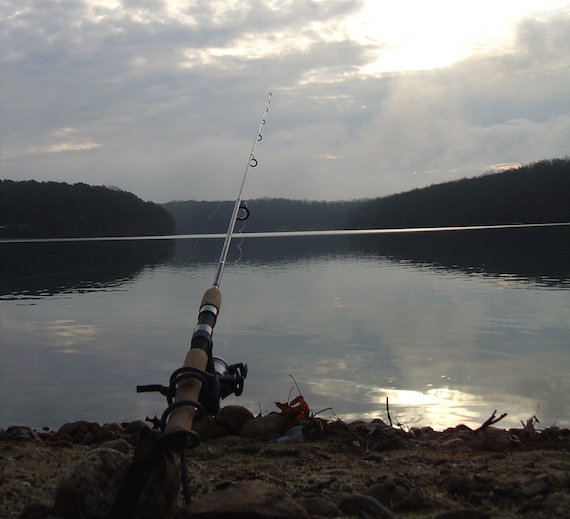
This is the ideal trout bait fishing setup.
Then hang a strike detector on the line between two of the top eyelets of the rod, (such as a bobber attached to an unfolded paperclip). When a fish takes the bait, the line pops out of the rubber band and runs freely.
Simply lock in the reel and set the hook. Trout can also be enticed to hit a small live shiner, smelt, or minnow when slowly worked along the bottom.
Topwater Fishing for Trout
You don’t always have to be fancy to be successful at trout fishing. The most basic methods our grandfathers used are still effective today and will remain so as long as fish feed on natural forage.
Large trout, especially browns, can be easily enticed by suspending a small shiner a couple feet below a balsa float (or bobber) during the low-light conditions of dawn and dusk.
This is basic fishing at its finest, and also a great way to engage the kids. For the more impatient types, try using a night crawler or garden worm.
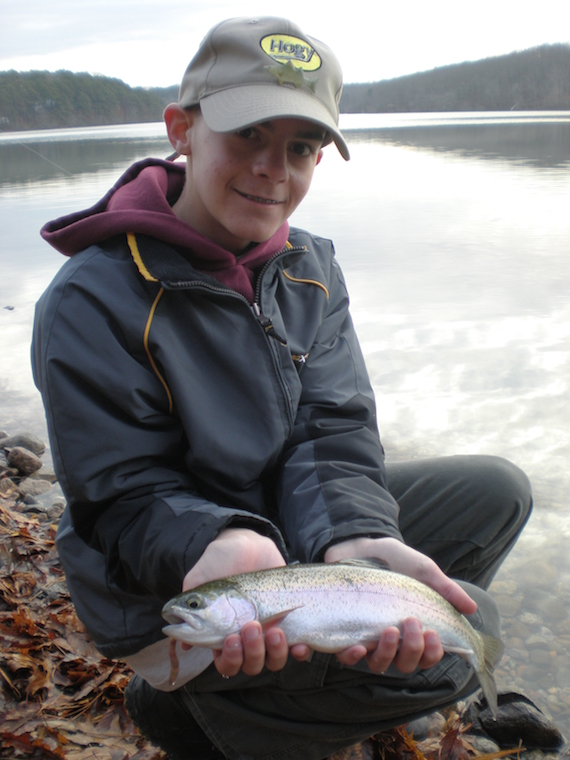
Trout fishing is a wonderful activity for the kids.
When wade fishing, a floating Rapala or similar style minnow-bait retrieved slowly along the surface creates a tiny wake and is deadly on aggressive trout; especially big browns.
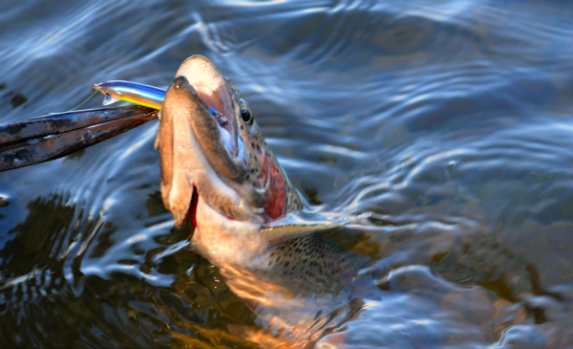
Fishing small swimming plugs for trout can be similar to surfcasting for striped bass-just with much lighter tackle.
Additionally, a fly or nymph can be used on spinning gear by adding a clear plastic float and slowly working along the surface.
Fly fishing tackle is also very popular and effective using a variety of dry flies and nymphs.
Deepwater Fishing for Trout
One of my favorite shoreline techniques for big, beefy holdover trout in deep water is what I like to call “long-range horizontal jigging.”
Tackle starts with a flexible 10-foot noodle rod spooled with 8 pound braid and a 6-pound fluoro leader about 12 to 16 inches in length. I employ a ¾- to 1-ounce spoon or tin—such as a Lil Cleo or a Hopkins Lure for example—and cast far and long.
Let the lure settle to the bottom before beginning the retrieve. If you are using a spoon with built-in swimming action such as the Lil Cleo, Dardevle, Goldfish, etc., simply roll it along the bottom very slowly, incorporating an occasional light twitch if needed.
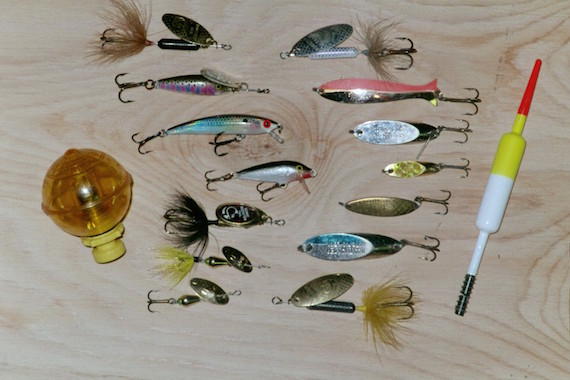
Here's the authors trout fishing arsenal. Note the metal spoons used for "long distance horizontal jigging."
When using jigging spoons or tins (Kastmaster, Hopkins, Crippled Herring, etc.) that have no built-in action, use short, sharp jerks of the rod tip. Always keep a tight line and maintain constant contact with the lure.
Be ready for strikes when the lure is falling.
If you’re not getting hits during these long retrieves, move around and feel your way along the bottom until you are successful. Often you will find multiple fish bunched up within their favorite, most bountiful feeding/holding areas.
A pond map is useful for picking out good shoreline spots where the depth drops off quickly, to about 25 to 40 feet deep.
Cast and Retrieve
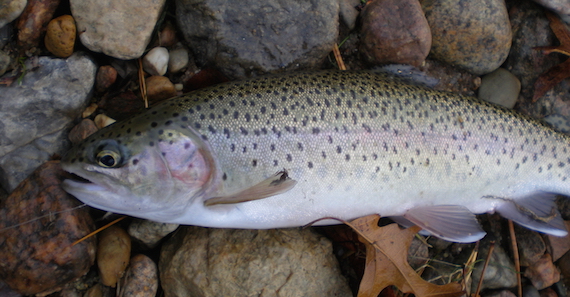
Casting and retrieving while wading around the circumference of a pond is a terrific way of exploring new areas (and of course catching trout).
Covering a pond step by step and fan casting is an enjoyable and efficient way to spend any morning (or late afternoon). Depending on the amount of angler pressure a pond may have, you can never go wrong by wade fishing.
Simply work the shoreline casting and retrieving a variety of small spinners and spoons, and switching lures until you have success.
Here are some specific lures I like to use:
- Panther Martin
- Mepps
- Blue Fox
- Roostertail
- Little Cleo
- Goldfish
- Krocodile
- Thomas Buoyant
For color, I always lean toward the classics:
- Gold
- Silver
- Nickel
- Copper
In low light conditions some of the latest ultra-violet reactive finishes are always worth a try.
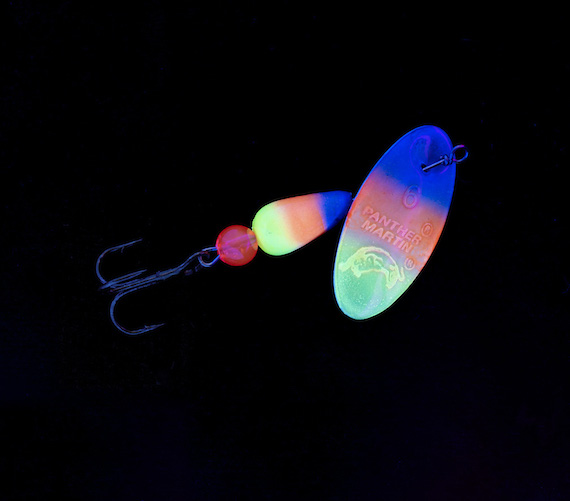
Ultra violet lures such as those by Williams/Mooselook and Panther-Martin (among others) are always worth a try during low light conditions.

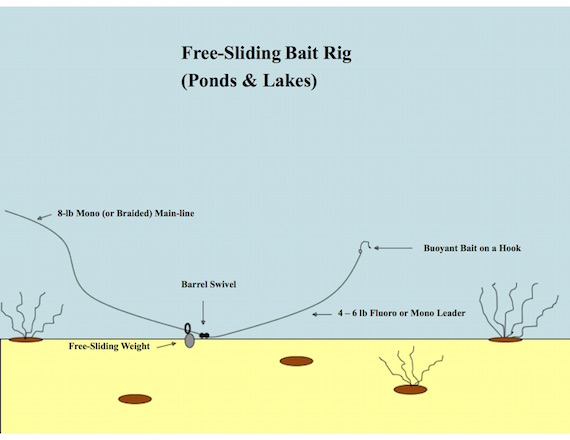
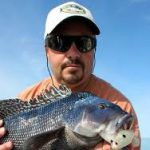
Where on the Cape can I fish for Brown Trout and Large/smallmouth bass in the Winter time?
There are tons of great ponds Bill. Is there a specific area of the Cape that you are most interested in? Let me know and I’d be happy to provide some ideas. For starters, a few of my favorite ponds for bass and trout include Peter’s Pond and Spectacle Pond in Sandwich, Hamblin Pond and Hathaways Pond in Barnstable, and Flax and Cliff in Brewster. Of course there are literally hundreds of others. Keep me posted!
Great report John! I’m a rookie fishing trout but it is a great early spring and late fall fishing trip. I’m a casting guy so I just wade walk and cast micro striper lures. Have had good luck with brown trout in the kettle ponds but I have no idea what I’m doing. I get pissed when the lure only goes 20 yards! But it’s fun anyway.
My question is; can I fish for trout until the ponds ice over, or do they stop bitting at a certain water temperature?
I have a bunch of lakes and ponds I can fish on my way home from work. Should I keep at it?
Yikes!
Hi N.T.
Thanks for your question.
Just to save myself a bit of typing I’m gonna cheat a little on this response and cut -n- paste the answer I gave Ryan after Part-I. I think it answers most of your questions, but if not feel free to follow up and I’ll do the same. And as for whether you should keep trying, absolutely! I’ve caught some of my biggest Kettle Pond trout and salmon during the Months of Dec, Jan, Feb…
“….When wading and casting in Cape Cod Kettle Ponds, often the question isn’t so much about “deep or shallow”, it’s will the fish be active or sluggish? Will they hug bottom or be suspended or feeding near the surface?
A lot depends on the conditions, specifically water temperature….. but as a rule I will typically cast spinners and wade during the milder months in spring and fall. (During fall: Oct, Nov, and maybe into the first week of Dec if it’s mild). After that, with the dropping water temperature, the fish begin to get real sluggish and they won’t move far (or quickly) to attack a lure. So that’s when I switch over to bait fishing.
As the temperature drops, trout start looking for easier meals in order to preserve energy. This doesn’t mean you can’t catch fish on lures, if you are persistent, but I just prefer to go with the best potential for success, since I tend to be a bit impatient when I’m wading cahones’ deep in frigid winter ice-water.
The rest really depends on what the weather is like in Jan-Feb, (personally I hope we’re ice fishing by then. If so I’ll try and set up a MFCC get-together out on the ice). If we have a mild “el nino” winter, with open water on the Cape all winter long, then the chances are greater that you’ll have trout holding and moving both deep and shallow, depending on the weather and conditions.
In short, if you are the very, very patient type and impervious to cold and numb knees, then enjoy. Best bet is to work those lures verrrrry slowly. I think patiently working a small sinking Rapala might be your best bet, or perhaps a small Super Duper, (you have to retrieve most spoons and spinners a little quicker to produce action or keep the blade going, so your “finesse” options are limited). If it was me and I wanted to “explore” and cover some shoreline, and lures were not producing, I might try casting small live shiners and dragging them slowwwwwly along the bottom with just a splitshot.
There’s so much more to it, many more variables that make bait fishing or lure fishing more or less effective on any given day, but I think in a nutshell that covers it.”
Stay warm.
JD.
Thanks John. I’ll keep at it.
Warren
Great read! I noticed in the pic of the spoons and metals u use for jigging there were two different style floats…are u using those with lures? Have u ever used the style float that u rig like a slip sinker? It comes with a stop that alows u to fish multiple depths with the float. Basically u slide the stop up ur line to what ever length leader u want to use and tie it off. Then u thread ur line through the float and tie on a short leader with a barrel swivel. The float can slide on the line but won’t slide down to the hook because of the swivel. When u cast out ur lure or bait it will sink to what ever deapth u set ur stop at. Be it 10′, 20′ or what ever. I’ve never tried it but I thought it looked good for fishing shiners down deep but keeping them off the bottom, or mid water column. Or maybe a jig that u want to fish real slow but not on the bottom…or are they crap?
Hi Brian,
Yes, that old photo is but a tiny fraction of what I have for spoons, spinners, and floats, lol. The floats themselves in the photo were just a couple throw-ins to provide an example. Personally I prefer balsa and cork flaots, light and tough.
Of all the fishing I do, trout, steelhead and salmon fishing runs deep in my heart. Accordingly I have waaaay too much stuff. (wink)
Yes, I tried the slip floats and I have several in my arsenal. I think they’re great. I’ve used them for steelhead (in rivers) and trout in ponds/lakes. It’s a great way you get the depth you want provided you use enough weight. The deeper you want to go, the more line that has to drag through the water toward the float and through as the bait/lure sinks. So if you’re fishing light gear from shore, sometimes it takes some wiggle to get all the line to slide through the float to get to the depth you want.
Over the years though, I’ve found that 2 to 3 feet deep is usually sufficient enough when shore fishing, so almost any float will do. But to your point, when I went walleye fishing in Minnesota from a boat using leaches for bait many, many years ago, the locals used floats to mark the exact depth they wanted the bait to be. So you’d be anchored and fishing with a sliding float in 20 or 30 feet of water.
JD.
Oh… and no, I haven’t used the slip floats with lures for trout (in ponds) but I have done so fishing in rivers, drifting with floats and weighted feather jigs. It’s a great way to go if you know the depth of the pool you are working at any given time. But usually I use slip floats with bait.
JD.
I grew up in upstate New York (think suburban area within the Capital District). I have been a fresh-water angler since I was a very young boy. My dad was an avid fisherman and he took me everywhere with him. There is nothing like feeling the hit of a nice-sized trout, early in the morning, surrounded by all of nature’s vast beauty. John’s articles are always a good read, but I took particular interest in this one. It brings back a lot of good memories. And I agree with everything he said, including his choice of lures and bait. My dad always had a “worm box”. I did too. My and my boys would go outside on the lawn when it was dark with flashlights and “catch” our worms. Man, that was fun.
Great memories Brian. Thanks. Sounds very similar to my childhood days. Nothing I loved more than standing on the banks of a clear mountain stream, hopping rocks, and catching wild brookies.
My grandfather was a devout, old-school worm fisherman. He used to say, “If there’s a fish you can’t catch with a worm, then ain’t worth catching”
JD.